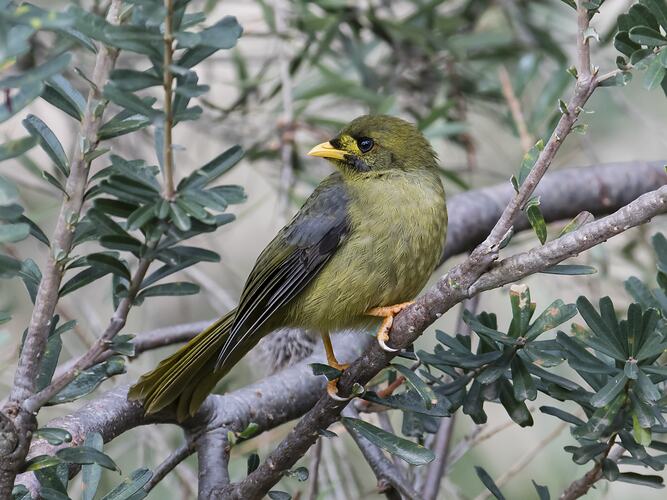General Description
A medium-large and solidly-built honeyeater that is the smallest of the miners. It is mostly olive-green, with a short, down-curved, bright yellow bill, a red-orange bare eye patch, and orange-yellow feet and legs. It has a square tail. The male is slightly larger, but otherwise the sexes are similar. Young birds are duller and browner, with a paler eye patch. Body size up to 20 cm.
Biology
More often heard than seen, the birds live in large colonies of 8 - 200 birds and aggressively defend their territories against all intruders. They mainly eat insects, especially psyllids and their lerps (sugary secretions used as protective shelters by the tiny psyllid insects) from the foliage of eucalypts. They also eat nectar and manna. The call is a sweet, musical, bell-like 'tink'. All birds in a colony call all day, with calls starting just before sunrise and finishing just after sunset. They have a complex social structure and are 'obligate co-operative breeders', which means that they are always helped by usually young or unpaired birds, but may also include other breeding adults who are also raising their own young. Found mainly in the temperate zone in broad gullies of foothills or on coastal plains, often at edges of rainforest areas.
Distribution
South-eastern Australia.
Habitat
Open eucalypt forests and woodlands with a dense shrubby understorey; occasionally found in suburban areas with remnant bushland.
More Information
-
Animal Type
-
Animal SubType
-
Brief Id
Medium-large, solid bird, mostly olive-green with a bright yellow bill, red-orange eye patch, yellow legs and feet.
-
Colours
Olive-green, Yellow, Red-orange, Orange-yellow
-
Maximum Size
20 cm
-
Habitats
-
Diet
Omnivore
-
Diet Categories
Insects, Nectar
-
Endemicity
-
Commercial
No
-
Conservation Statuses
CITES: Not listed, FFG Threatened List: Not listed, EPBC Act 1999: Not listed, IUCN Red List: Least Concern
-
Taxon Name
-
Common Name
Bell Miner
-
Kingdom
-
Phylum
-
Subphylum
-
Class
-
Order
-
Family
-
Genus
-
Species Name
melanophrys

